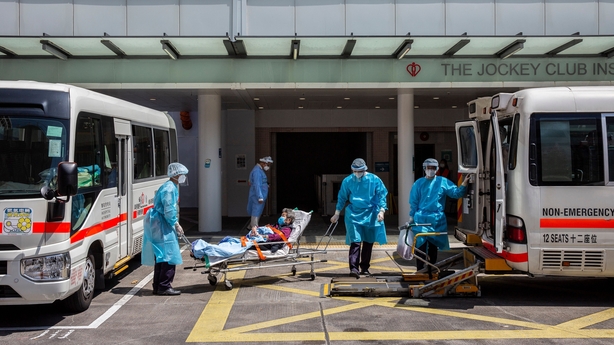Mainland China reported 402 locally transmitted Covid-19 infections with confirmed symptoms, official data showed, nearly doubling from the daily count on Tuesday.
Of the new local symptomatic infections, 165 were in the northeastern province of Jilin, the National Health Commission said in a statement.
That marks the highest daily count for the province since China contained its first national outbreak in early 2020.
The number of new domestically-transmitted asymptomatic cases, which China does not classify as confirmed cases, was 435, a near two-year high.
Still, China's caseload is tiny by global standards. The country is sticking to its "dynamic-clearing" playbook where local authorities scramble to identify and quarantine every infection and their close contacts quickly and impose varying degrees of curbs to cut transmission.
In the city of Jilin, the hardest hit area in the latest flare-up in the province which is battling an outbreak where a sub-strain of Omicron has been found, business operations in it suburban areas have been ordered to halt for a week with exceptions being made for those responsible for providing essential services and businesses requiring continuous production.
People are not allowed out of their homes in general during 7-13 March, except for urgent matters such as to seek medical services, according to the city government.
One person from each household will be allowed out each day to shop for necessities.
There were no new deaths reported for 9 March, leaving the official death toll unchanged at 4,636.
As of 9 March, mainland China had reported 112,385 cases with confirmed symptoms, including local ones and those arriving from outside the mainland.
Hong Kong leader plans to reopen city only after controlling latest Covid outbreak
Hong Kong leader Carrie Lam has said it was not the time to lift a ban on flights from nine countries including the United States and Britain, with plans to reopen the city only after the government controls a deepening coronavirus outbreak.
The global financial hub has some of the most draconian restrictions in place to combat a surge in coronavirus cases that has seen the city suffer the most deaths globally per million people in the week to 7 March, according to the Our World in Data publication.
Total infections have surged to about 600,000, including about 3,000 deaths - most in the past two weeks.
Health authorities reported 31,402 new cases today, and 180 deaths in the past 24 hours.
The Chinese territory has had its borders effectively sealed since 2020 with few flights able to land and most passengers banned from transiting.
"This is not the time to lift the ban. A lot of people will rush to come back...there will be infected cases and that will add a lot of pressure to our public hospital system," Ms Lam said.

Her comments come a day after she announced a shift in her government's approach to tackling the coronavirus, devoting more medical resources to elderly people as infections and deaths climb rapidly amongst the city's mainly unvaccinated elderly population
Hong Kong's government had previously focused its resources on identifying, treating and isolating all cases, even those that are asymptomatic and mild, adding pressure on its hospitals and healthcare system.
Until recently, the government said it was focusing its efforts on carrying out compulsory mass testing for Hong Kong's 7.4 million residents sometime this month.
Contradictory messages from authorities over the scheme and plans for a city-wide lockdown have sparked panic buying by residents, who have been emptying supermarket shelves for over 11 days.
There was now no time frame for the testing, Ms Lam said yesterday.
The change in approach came after a top Chinese official said that Hong Kong had to prioritise reducing infections, severe illnesses and deaths.
Hong Kong, like mainland China, has adopted a "dynamic zero" strategy that seeks to curb infections with strict mitigation measures. The approach has been severely tested by the fast spreading Omicron variant.

